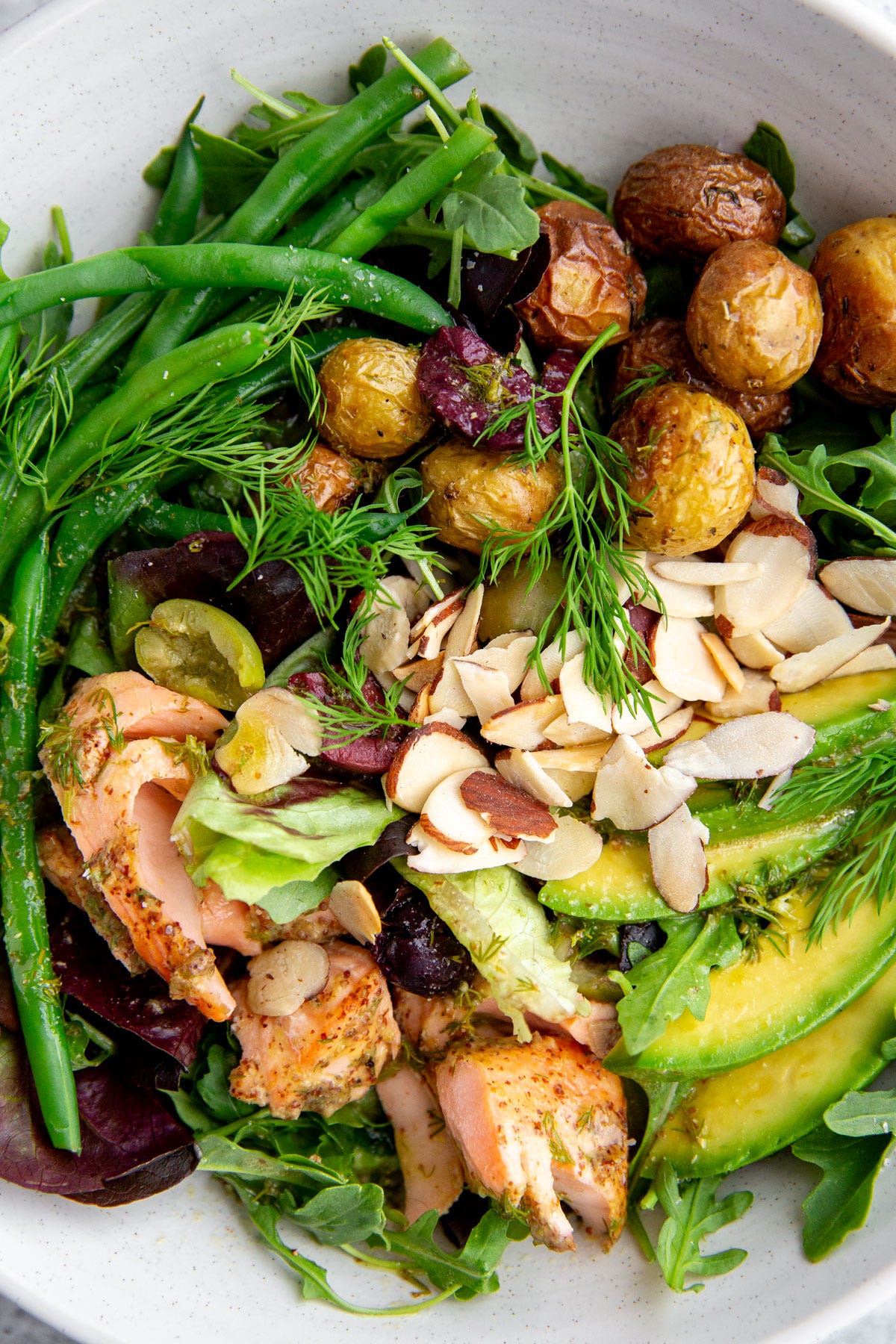This, my friends, is my dream salad (except, it’s not a dream, because we’re going to make it). It features honey mustard glazed salmon, tender roasted baby potatoes, green beans (or asparagus), olives, avocado, toasted nuts, and a bright dilly mustard vinaigrette. It’s versatile and adaptable, and it’s what spring evenings are made for.
In memory
This week, after this newsletter was drafted, my community lost a dear human, a local business owner, fashion designer, and the mother of one of my daughter’s closest friends. Heartbreak is too small of a word. I want to dedicate this newsletter to Stephanie Doucette. Thank you for bringing so much beauty and grace into our lives. Let’s go hug our people, slowing down this weekend to appreciate all we have, in honor of Stephanie.
Nicoise salad will forever remind me of my time in Southern France, eating outside at cafés and lingering over glasses of rosé. It’s been a dinner staple in my house for years, especially as temperatures climb. We eat it Build-a-Bowl style, where I throw all of the components on the counter, and everybody gets to make their own bowls (or, in the case of my nine-year-old, a plate with little mounds) adding whatever they like (or avoiding what they don’t like—we see you olives). While we often use good quality canned tuna, this is my favorite version, featuring tangy-sweet roasted salmon and *not-traditional* avocado. It’s a meal that begs to be savored slowly, preferably outdoors or with a window thrown wide open, feeling the warmth of the season on your bare arms, lingering as the light shifts towards golden.
Slowing down
Slowing down, even if just for a regular old Tuesday night dinner, often feels like a privilege. I don’t know about you, but apart from the parable of the tortoise and the hare, I was never taught that moving slowly was the best way (or even a way) to go about life. After all, we live in a culture that valorizes productivity and speed. Abigail Rose Clarke describes this in her book, Returning Home to Our Bodies, which, as I shared last week, I’ve been reading slowly (pun not intended):
“High-speed internet. Rapid travel. Overnight success stories. A push to move faster, grow faster, more, more, more.”
We all desire the quick and visible; it’s natural. However, there’s a downside to all this speed and urgency, which Abigail describes (on page 83):
“It’s understandable, and yet: urgency is rooted in the culture of domination and extraction. Slowing down is not an excuse for inaction, but must always be a precursor to action. If we don’t slow down, our actions will originate from the cultural paradigms we claim to be resisting. When we slow down, we give ourselves a space between stimulus and response.”
Slowing down is essential for creating the necessary space for response as opposed to reaction. Our reactions are at the whim of our emotional highs and lows, burning hot and fast, often spreading destruction in their wake. While fiery reactions often feel good in the moment (oh yes, I’ve been there!), rarely do they feel great afterwards.
In a culture that feels more and more divisive by the day, it feels more imperative than ever to slow down in order to make the space for conscious response as opposed to emotional reaction, where our words and actions stem from feelings such as anger, fear or judgement.
It takes practice and intention to slow down. The truth is, we are all busy. However, slowing down doesn’t have to look like canceling our activities or spending hours at the dinner table every night. Sometimes it can be as simple as taking two deep breaths, creating space to detach from the throes of emotion in order to better respond with clarity and equanimity.
In the kitchen
An easy place to practice this is in the kitchen. As I’ve described before, I have a simple practice of taking two deep breaths before eating, which my family does together every night before dinner. Instead of immediately diving into the meal (which is certainly our impulse!), we pause to give thanks to the food in front of us, to our bodies, and to each other. The pause of two breaths reminds us to turn off autopilot and slow down, helping us better connect with our food and with our bodies.
One of the other benefits of slowing down in the kitchen is that it also opens the door to more pleasure. If we take a minute—really, that’s all it takes—to get embodied we can experience the pleasure of our senses and open to beauty (which, as I discussed last week, can be the doorway to a deeper connection with the world). When I’m engaged with my senses I’ll notice the sparkle of fresh lemon juice as I squeeze it into a bowl and smell the grassy greenness of dill. I’ll really taste my food, instead of just shoveling it back.
There are (many) days when life is rushed and the kitchen feels like a mere means to an end, but with a bit of intention we can use the process of feeding ourselves as a deeper form of nourishment. There’s nothing wrong with moving quickly and efficiently, but in slowing down (even if just for a few seconds), we begin to bring more consciousness into our actions, teaching our brains to pause and respond instead of unconsciously reacting.
Invitation
As Abigail explains, it might feel like a paradox to slow down when there is so much to do (truly), but, as she says, “the body is home to so many paradoxes, and one of them is the ability to widen time when we are willing to slow down.”
My invitation this weekend is to slow down into order to widen time. Let’s move more deliberately and intentionally, even if it’s just for a single meal or snack, in order to experience more connection in our lives (and more pleasure). Even if you only have three minutes to eat an orange, can you feel into each minute, using all of your senses to widen time and fully taste the sweetness of the fruit?
The more space we give ourselves to breathe and respond in the kitchen, perhaps the easier it will become to do this in our wider lives as well.
Mother’s Day weekend
I’m in a much different place now than I was last year on Mother’s Day weekend, when I was on the tail end of a health struggle, which you can read about here. One of the gifts from that time was that I learned how to mother myself in a much deeper way. I think we can all benefit from mothering ourselves more right now. No matter your gender or whether or not you have kids, I hope that you’ll spend time this weekend to shower yourself with care and nourish yourself with love. Give your inner heart exactly what it desires. Be the mom to you that you need, in this moment.
I’ve shared some of my favorite Mother’s Day brunch and dessert recipes below, which you can make for the mother figures in your life or for yourself (or you can send the recipes to your people and ask them to cook for you).
Honey Mustard Salmon Nicoise (with all my Favorite Things)
This salmon Nicoise salad is a lovely meal to linger over, either for brunch or for dinner (perhaps with these crab cakes to start, if you’re feeling fancy!).
It’s actually three recipes in one, as the honey mustard salmon, the seasoned roasted potatoes, and the dilly mustard vinaigrette are all delicious in their own right. When combined in salad form, however, the result is a dynamic one-dish dinner that’s bursting with texture—creamy warm potatoes, cool green beans, tender salmon, buttery avocado, crunchy nuts… oh la la. It’s a meal that begs to be eaten outside with a crisp glass of rosé, savoring life, widening time.
Mother’s Day Sale
This weekend I’m offering a Mother’s Day sale, where you’ll get 20% off a paid subscription forever! This work takes a considerable amount of resources to make happen (including researching, writing, developing recipes, shopping, and producing a podcast) and it wouldn’t be possible without reader support. I know we’re all being asked to pay for more content these days, but it means that we’re putting our dollars towards authentic creation and exchange. If you find the work valuable, I hope you’ll consider going paid. Thank you!
Keep reading with a 7-day free trial
Subscribe to Mind, Body, Spirit, FOOD to keep reading this post and get 7 days of free access to the full post archives.











